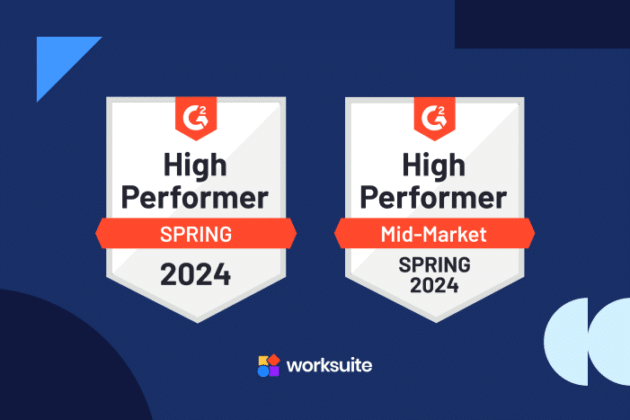
The Finance Guide to Contingent Workforce Management
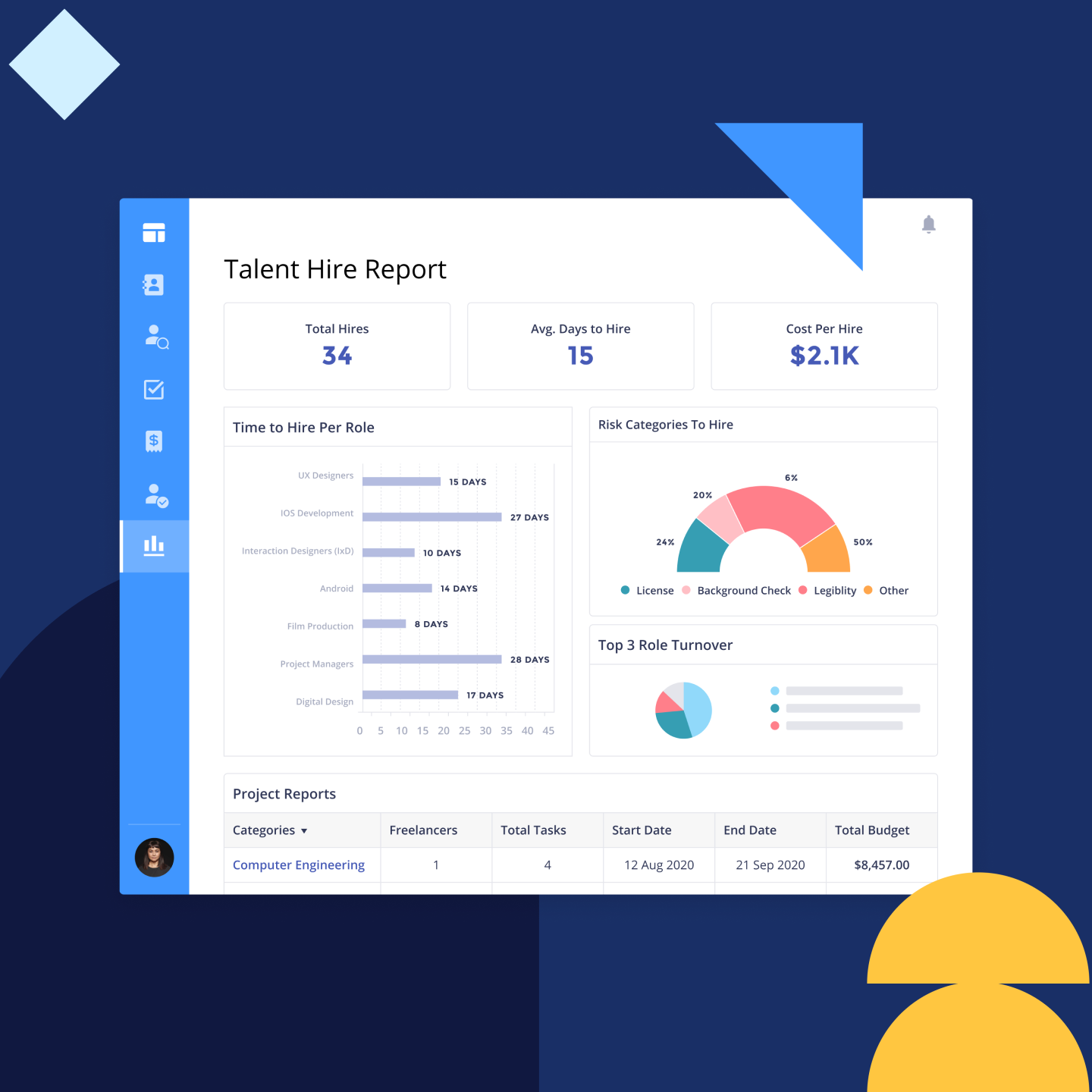

The World Bank estimates that 46.4% of the global workforce are freelancers. As more companies turn to flexible staffing solutions to meet their operational needs, it’s important for Finance departments to keep track of and pay workers that don’t fit into the standard employee classification.
Engaging freelancers is great for business, allowing teams to find skilled labor faster, hire in more places, and deliver results to clients and customers at scale. However, Finance departments are left with the daunting responsibility to pay freelancers, report on spend, and maintain compliance in an ever-changing global gig economy.
As the freelance economy grows, so does the complexity of financial controls and reporting needs. Freelancers have traditionally been a part of the financial reporting world. However, they’re now being recognized as a growing force in the payroll and tax accounting arenas as well.
An increasing number of freelancers are not just working outside the traditional office setting, but also operating within a complex web of business relationships that require communicating their financial information clearly and efficiently — to both internal and external stakeholders.
In fact, the freelance workforce has exploded in recent years: according to a study by Edelman Intelligence, a division of Edelman marketing research firm, the number of people who work independently of an organization grew by 20 percent year-over-year from 2013 to 2014. That’s an additional 14 million people working outside of traditional employment relationships.
How can Finance teams keep up with these trends?
This guide gives Finance teams critical and foundational knowledge to adapt to an ever-growing contingent workforce model. The following sections will make reference to Worksuite’s Freelancer Management System (FMS) to seamlessly manage and pay your external talent.
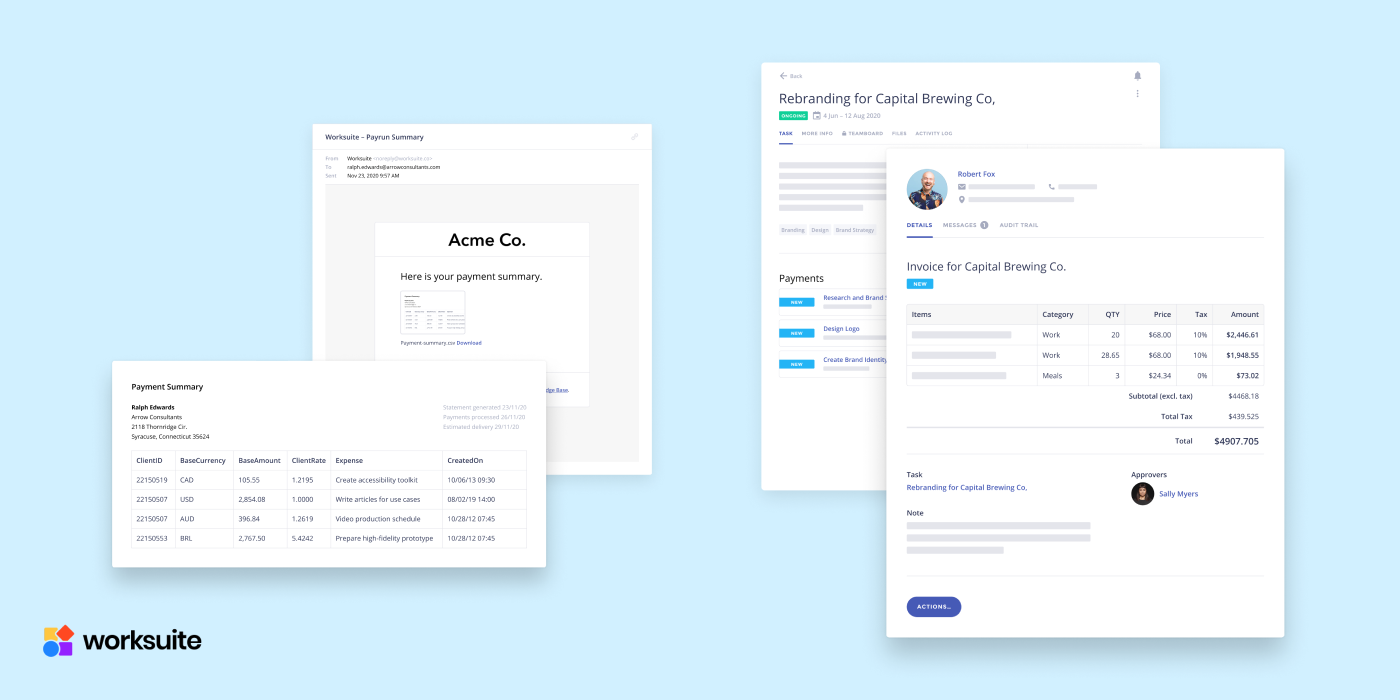
Global Payment Processing
Invoice Management
Invoice Management allows freelancers or teammates to create invoices for payment. Having a consistent invoice management process is important because there are financial codes that are required to perform financial reporting, to track spend, and analyze costs across departments and cost centers.
With Worksuite, both managers and contractors may generate an invoice directly from a task, which enables tighter accounting and eliminates administrative burden.
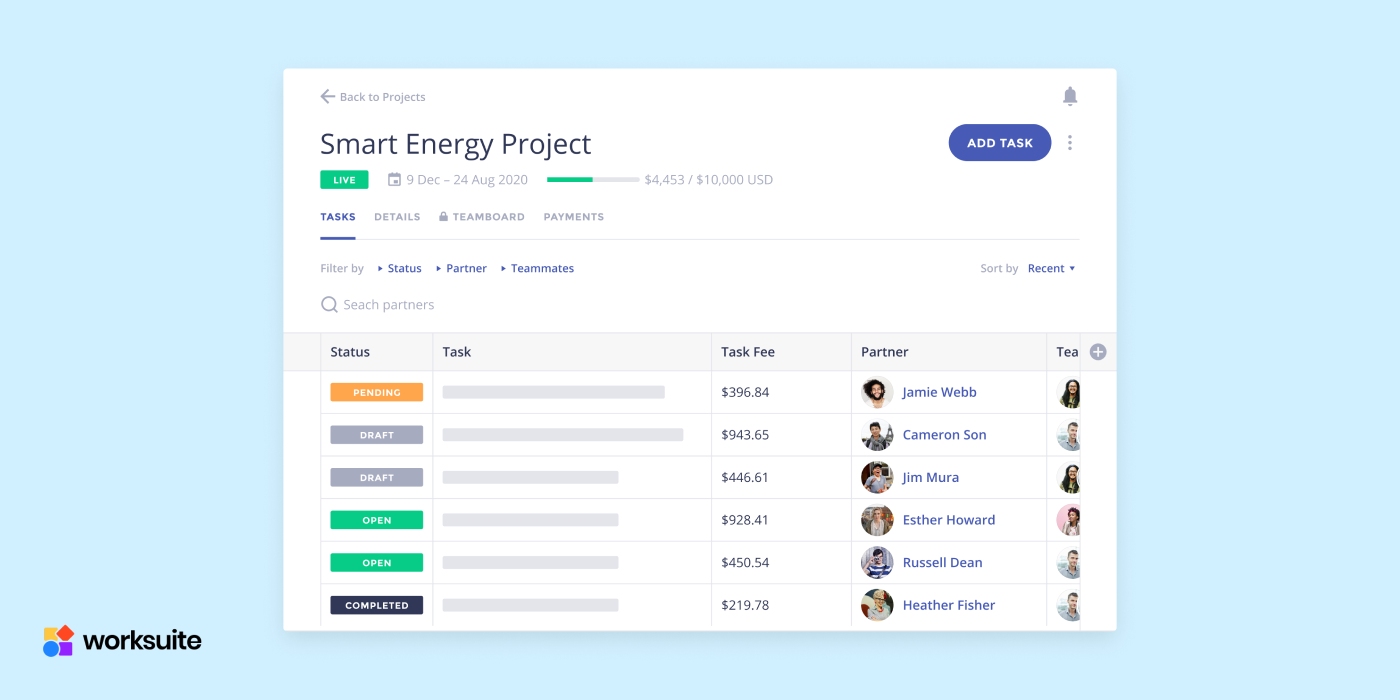
Task and Projects
You can use a project management tool to track costs — making sure that all linked tasks are coordinated to provide outcomes on schedule and under budget. To achieve this, while starting a new project in Worksuite, include the project start and finish dates as well as your overall budget. Costs for any related tasks will be automatically added to your overall budget. Tasks will also only be created throughout the designated project timeline!
What’s more, you may view a quick “gut check” to see how each project is tracking toward its allocated budget, by simply hovering over that column in Worksuite or looking at the top of the project dashboard.
Scope of Work
Invoice Management starts not with the invoice but with the Work agreed to be performed. Long before an invoice is raised, a manager decides what work needs to be completed and coordinates with the contract on the deliverables, payment, and timeline.
Freelancer visibility into the work that needs completing is critical, since they can more easily track pending work and communicate with you on deliverables. Using Worksuite’s Tasks and Projects module allows for the simple creation of a structured work management tool for projects to easily come together across various freelancers — all contributing to the project.
Most importantly, tracking financial codes is required for teams to measure spend.
Two-Level Approval
In accordance with best Accounting practices, invoices in Worksuite are first approved and then scheduled for a pay run. Most organizations opt to divide these tasks across different team members.
Tracking Timesheets
With Timesheets, you can see when your employees worked and how much time they spent on each task. This information helps you make better decisions about hiring new staff, adjusting work schedules, or budgeting for next quarter/year. It also lets you bill clients accurately for services rendered.
There are many ways you can track time, whether it’s:
- half-day / full day
- EOR Compliant Timesheets with start/stop times
- start/stop clocks for billable hours
- or general weekly timesheets
It’s also important to remind contractors to submit their timesheets so that you maintain your financial process flow without disruptions.
After a timesheet is submitted for review, a manager approves it, and they may automatically generate an accurate invoice based on those hours logged.
As a manager, you will probably set up different rules for how your organization handles timesheets. For example:
- Total fee for the agreed-upon project. Freelancers that work on projects don’t need to submit timesheets. They’re paid based on the project estimates and deliverables. These estimates have already been approved by the client so there’s no need to track time.
- Track billable hours diligently. Hourly employees typically submit timesheets every week. You may consider requiring this for your freelancers too.
Delivering Payments to Your Contingent Workforce
Worksuite is the leading platform for managing freelancer payments in 120 currencies and 190 countries. The Worksuite team has built one of the most efficient digital payment systems in the world. That said, delivering payments globally is no easy task. Worksuite has invested heavily into ensuring global payment processing is as smooth as possible – for both your team and your talent. We’ve done the heavy lifting so you don’t have to.
Freelancer payouts require a simple yet robust process for getting payments out the door and into the bank accounts of your top talent. If you experience delays on payments, and a freelancer doesn’t get their money on time, your brand reputation and confidence in the eyes of your talent are at risk.
The biggest problem is how to effectively land funds without doing all the necessary paperwork or back-and-forth to collect bank details. Not to mention, there are security and compliance risks to paying global contractors. Worksuite takes care of it all — removing the administrative burden and compliance risk from your team’s plate. All you do is approve invoices and schedule when the payments go out, and we take care of the rest. Then, your freelancers gain visibility into the status of their invoices at each point in the lifecycle.
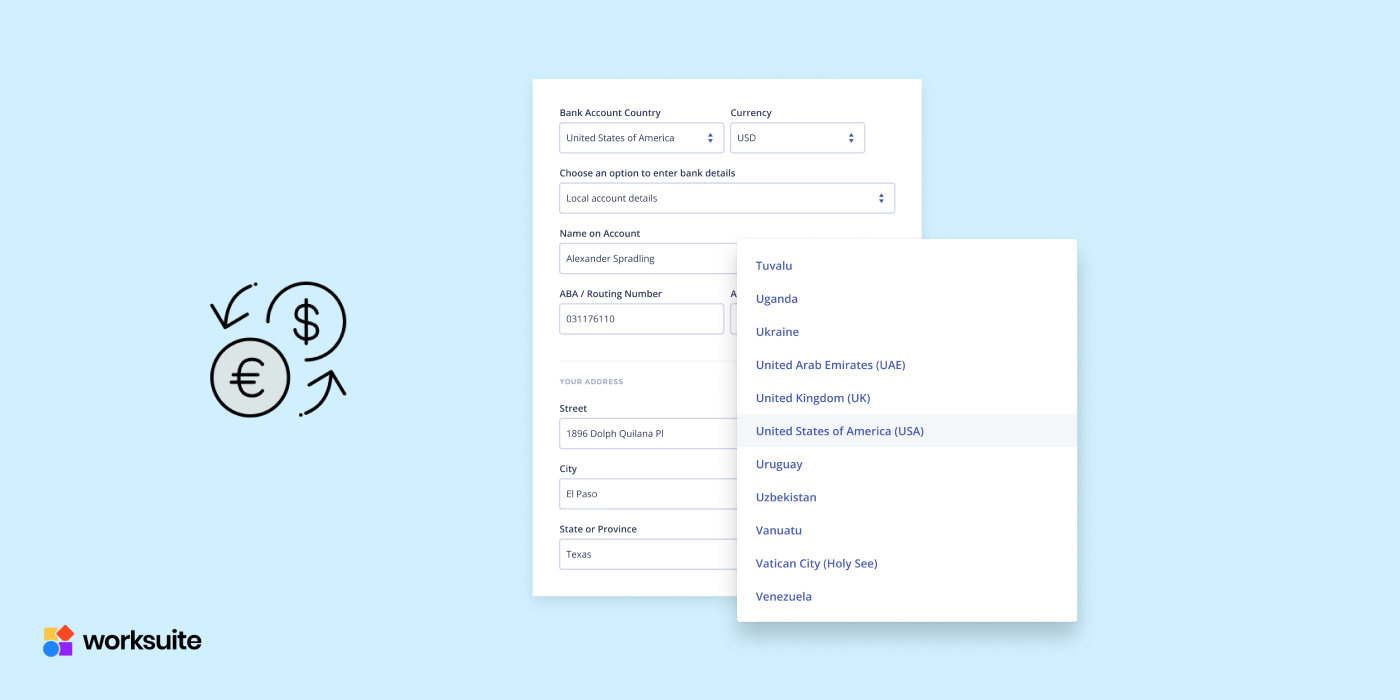
Collecting Bank Details
Successful payment delivery begins with accurate bank account data collection. Our robust bank details collection workflow leverages real-time validation on a country specific level.
What’s more, Worksuite’s payment support team remains available to address inquiries from your talent partners to ensure we collect payable details before any payments are sent. Once completed, Worksuite stores this sensitive data using bank-level encryption and ISO 27001 certified data management. Simply put, we take information security very seriously.
Currency Management
Your Finance team may choose which currencies your freelancers invoice in or contract in, and the currency you fund in.
Freelancers can choose the currency they’d like to receive their payments in — with over 120 global currencies supported by Worksuite Global Pay.
Worksuite handles the FX trades and conversions to ensure your freelancers are efficiently paid the right amount at the right time. This process leverages real-time bidding across 20+ liquidity partners & FX providers, to get you the best rate possible.
For your talent, this means the ability to receive a payout in nearly any bank account and any currency they want, and your Finance or Accounting team has nothing extra to do to allow this to happen. For example, there is no accounting for FX gain/loss as you’d fund in a single currency of your choice.
- Funding currency: the currency that you fund payments in, sometimes referred to as the ‘base currency’.
- Contracting currency: the currency that you contract in with the freelancer, sometimes referred to as the ‘invoice currency’.
- Receiving currency: the currency in which the freelancer chooses to receive their payments, when they set up their bank details.
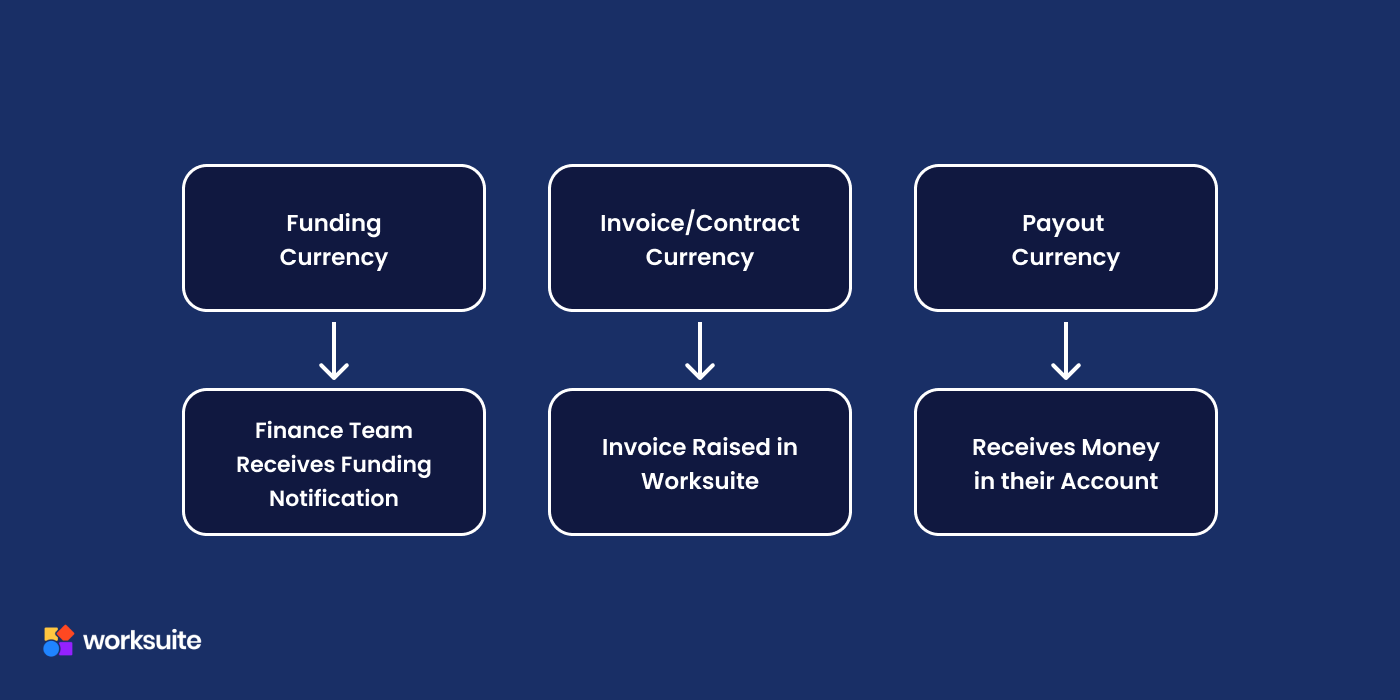
FX Trade & Fees
- FX Rate: the value of one nation’s currency versus that of another nation or economic zone. Most FX rates are free-floating and rise or fall based on market supply and demand. Some are fixed to the value of other currencies.
- Liquidity Pool: the group of banks who bid, in real-time, on FX each payment that requires trading (a process that ensures the best FX rate for both you as the Worksuite customer, and your freelancers).
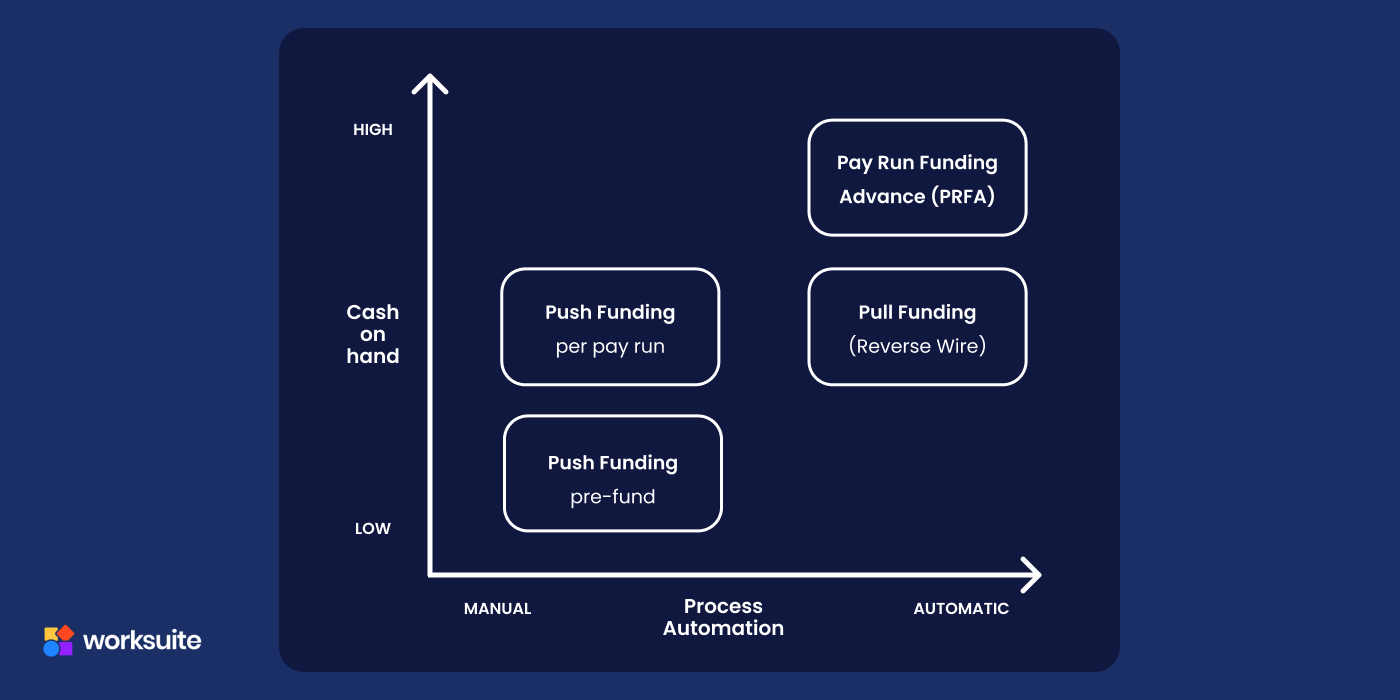
Funding
Payment Processing Funding Account (PPFA)
For each set of payments we process to your freelancers, we receive your funding in a dedicated Payment Processing Funding Account (PPFA).
Upon KYC review and approval, we will establish your PPFA with a unique and static set of wire details.
Worksuite offers various options to fund this account to suit your Finance or Accounts Payable preferences.
After each pay run, Worksuite emails your Finance team a pay run funding notification. When contracting with your freelancers in multiple currencies, this takes the form of a comprehensive ‘trade reconciliation report’ detailing our conversions from the receiving currencies to your funding currency — balancing out to your ‘pay run funding statement’.
Funding Options
Pull Funding (Reverse Wire)
Worksuite automatically debits your account for the funding total for each pay run.
Benefits of Pull Funding:
- One-time bank authorization process
- Hands-off convenience
- Payments send without awaiting arrival of funding
- Recommended option for ease and speed
Pay Run Funding Advance (PRFA)
Do you have lots of red tape and time required to get a wire scheduled or payments approved? Worksuite has you covered.
With PRFA, Worksuite funds your pay run upfront and invoices your for funding amount and processing fees together, on terms of your choosing:
- Net 30: 4% fee
- Net 60: 6% fee
- Net 90: 8% fee
Benefits of PRFA:
- Frees up cash on hand
- Hands-off convenience
- Payments send without awaiting arrival of funding
- Preferred option for Procure-To-Pay (Worksuite does not produce funding invoices)
Push Funding
Unique and static wire details allow you to manually transfer funding:
- Per pay run – Push a wire upon receipt of the funding notification from Worksuite with the total amount to send for the pay run (payments await funding before sending)
- Pre-fund – Option to pre-fund the account to remove delay (loss of operating cash)
Freelancer Payment Support
As part of Worksuite Global Pay, our payment support specialists field all inquiries from your talent as well as banks. There are many types of support that freelancers may request — we take these off your administrative plate.
Proactive Inquiries
- Rejected payments, invalid bank details, compliance cases
- Even though we perform compliance checks on the recipient bank details, payments can still be held…
- Even though we perform real-time validation, typos happen, routing info changes…
Reactive Inquiries
- Where’s my payment?
- Payment not received
- Processing fees
Taxes & Compliance
Worksuite is here to help you manage the complexities of paying taxes in multiple countries and jurisdictions.
We built our own payment processing platform to handle all of these issues, so you can focus on doing what you do best: creating great work.
Yearly 1099 Processing
Collecting Tax Information and Documents (for example, W9 / W8 / W8-BEN) in the platform through an automated onboarding workflow is simple and quick. As part of Worksuite’s Global Pay service, we offer to file 1099s on your company’s behalf. We also offer comprehensive Australian Superannuation services.
To date, Worksuite Global Pay has filed tens of thousands of 1099s on behalf of our customers. Plus, we’ve processed over $500 million in contractor payments to date (as of May 2023).
Managing taxes globally is no easy feat, which is why we also offer Worksuite Global Engage to protect you from local compliance regulations that you may not be familiar with.
When you’re getting paid for a project, there are some fees and taxes that may be applied to your invoice. These can vary based on the industry you work in and sometimes even the type of work you do, so it’s important to know what they are and how they affect your payments (and your bottom line).
Some common tax challenges you may encounter
- Sales tax: A tax charged by states or local governments on the sale of certain goods or services (GST) within its jurisdiction.
- Example: New Zealand freelancers who make more than NZ$60,000 must pay a 15% GST, and they often bump up their rates or add this to their invoices.
- Value added tax (VAT): A value-based sales tax levied either by national governments or subnational entities such as cantons or states, to allow them to recover part of their expenditures from providing infrastructure needed for economic activity.
- Example: Contractors in Argentina pay 21% VAT, and will often pass through this cost to their clients (you) via their invoice.
- Superannuation: Australian retirement accounts. Employers in Australia must pay at least 11% of your ‘ordinary time earnings’ into your retirement account as an employee. This makes it critical to classify your contingent workforce correctly.
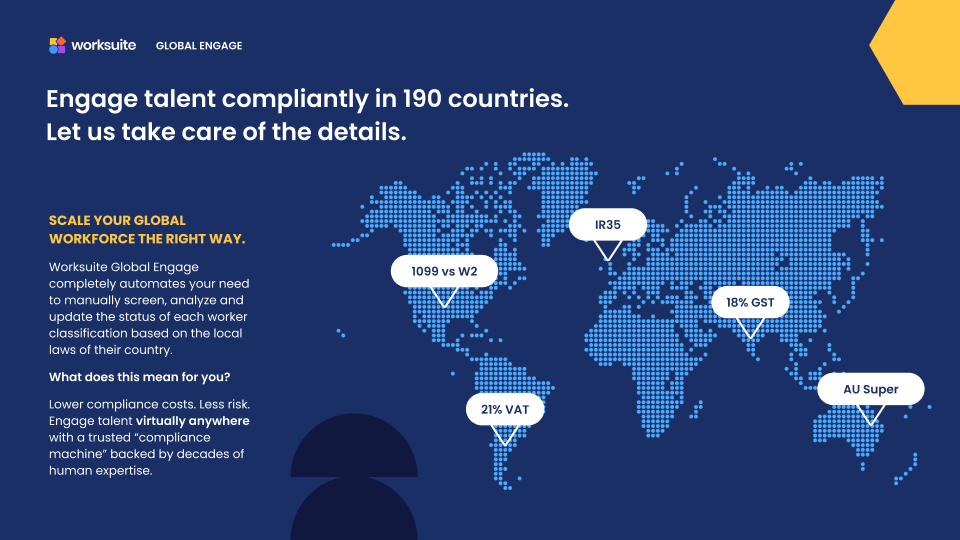
Worksuite Compliance Services
We have a range of services to mitigate risk, from Global Engage to partnering with AOR or EOR service providers in a seamless, all-in-one process.
There is no “one size fits all” approach to international compliance. Therefore, Worksuite offers 4 custom tailored tiers to ensure you’re engaging global talent the right way:
- Global Engage Direct: Leverage Worksuite as-is with the addition of our compliance consulting, to scale your talent engagement & internal compliance processes.
- Global Engage Plus: Worksuite classifies talent on your company’s behalf in compliance with local laws. Worksuite also indemnifies your company.
- AOR: Worksuite engages & pays freelance talent on your company’s behalf, on top of determining each worker’s classification.
- EOR: Worksuite employs & payrolls talent on your company’s behalf, on top of classifying and acting as AOR.
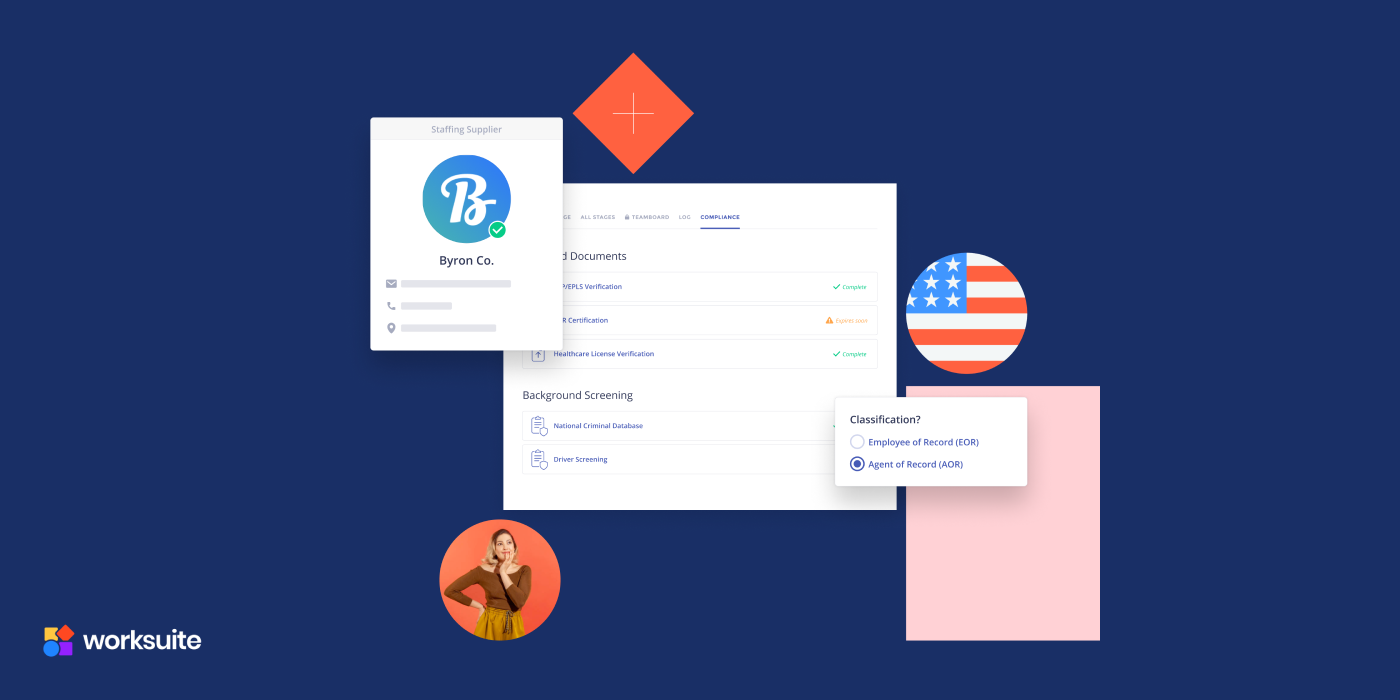
Contingent Workforce Reporting
Metrics
Finance teams can gain deep insight into Workforce Analytics (WFA) to report on any data point within the Worksuite platform. For example:
- Accrual report – easily track invoices raised during a specific period
- AP report – track invoices paid during a specific period
- Accrual forecasting – project talent spending using task schedules & fees
- Month-to-date comparison with previous year and projects
- Talent spend by project or department
- Weekly billing
- Timesheet tracking
- Custom reports
With Worksuite, you can configure your projects, tasks, and invoices to include finance codes (GL, project, budget, etc.) to link expenses back to your own Revenue & AR reports.
Spend
Track freelancer spend more effectively by seeing top-level charts and graphs for your executives. Not only can you identify projects that are over-budget, but you can also drill down into spend by manager, department, or other financial reporting metrics.
See your month-over-month freelancer spend data to see how your spend is performing in relation to your revenue. Make sure you’re getting the most out of every dollar by using Worksuite’s Workforce Analytics.
Accruals
Accrual is the most accurate way of tracking spend, but it can be difficult to manage. It requires detailed reporting and analysis to ensure that budget allocations are allocated in a consistent manner.
Accrual tracking is used by companies of all sizes. It’s ideal for organizations with multiple departments, multiple budgets and complex resource allocation structures. Accrual helps organizations keep track of how much they have spent and what their budget obligations are over time.
Accrual tracking allows you to see exactly where your money is going by comparing your actual expenses with your budgeted amounts. This way, you can see if you’re overspending on certain items or if there are areas where you can cut back on spending without hurting overall productivity.
Accrual tracking also allows for greater visibility into project costs, which makes it easier for managers to manage their budgets more effectively.
In addition to helping track spending, accrual also helps reduce costs by eliminating wasteful spending on projects that don’t meet their goals or deadlines. The system also provides a way for managers to compare different department budgets so they can make informed decisions about how to allocate resources across departments or projects based on the needs of each organization.
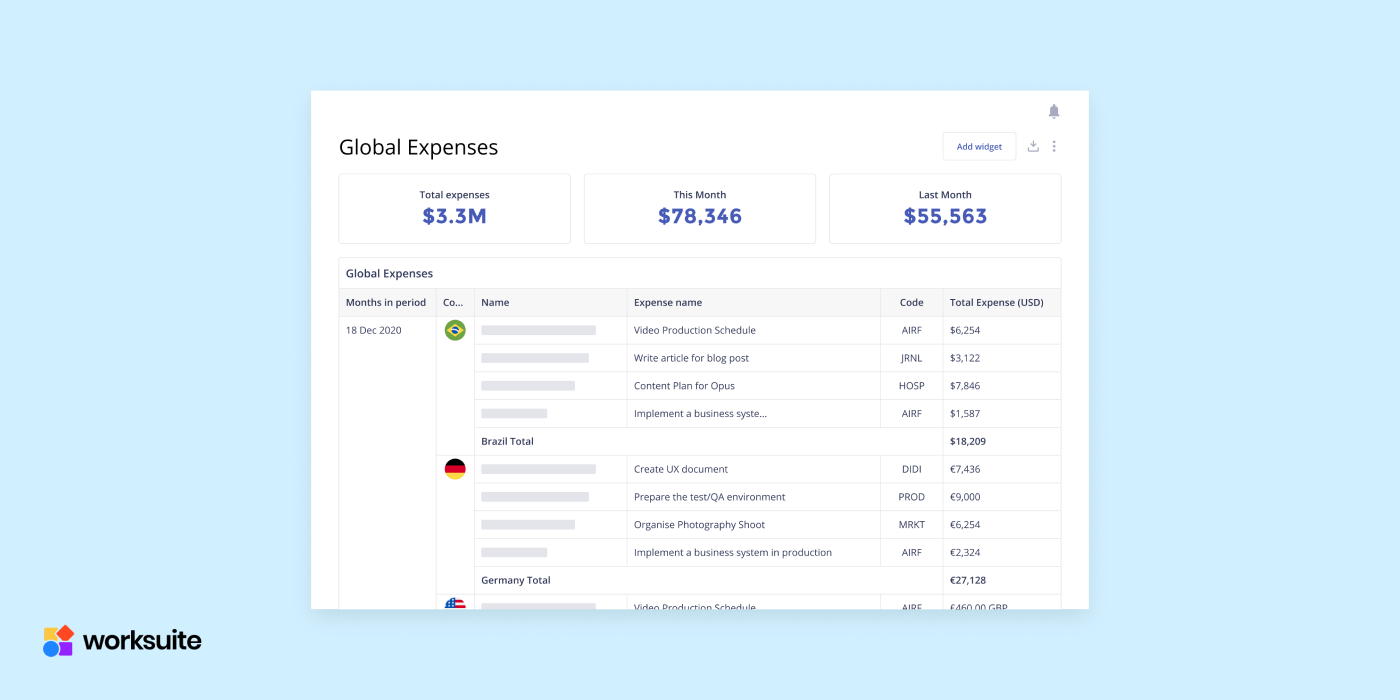
Spend Forecasting
Forecasting spend is important to maintain proper cash flow. Stay in the know by leveraging simple data such as Task End Date and Task Fee to see how much you’re forecasted to spend over the next 3 months.
The Spend Forecast is a great tool for looking ahead on your projects, but it can also help you stay on top of your budget by monitoring current spending. The view will automatically update with any changes made during the month, so you can easily see if your tasks are coming in under budget or over budget.
Below are some of the most common ways Worksuite users leverage this:
- Planning: Use Forecasting to plan ahead for upcoming projects by looking at your historical data. Find out what your average spend per task is and add it up over time to determine how much money you’ll need for your next project.
- Spend Forecasting: When you have a new project coming up, ask yourself: “How much will this cost?” The answer might surprise you! We recommend using multiple time periods so that your results are more accurate.
- For example, if you’re looking at a six-month forecast, do it in quarters or even months rather than days or weeks. This will give you a clearer picture of what’s going on with your finances over time, and help prevent surprises later when you don’t have enough funds available for an important project or initiative.
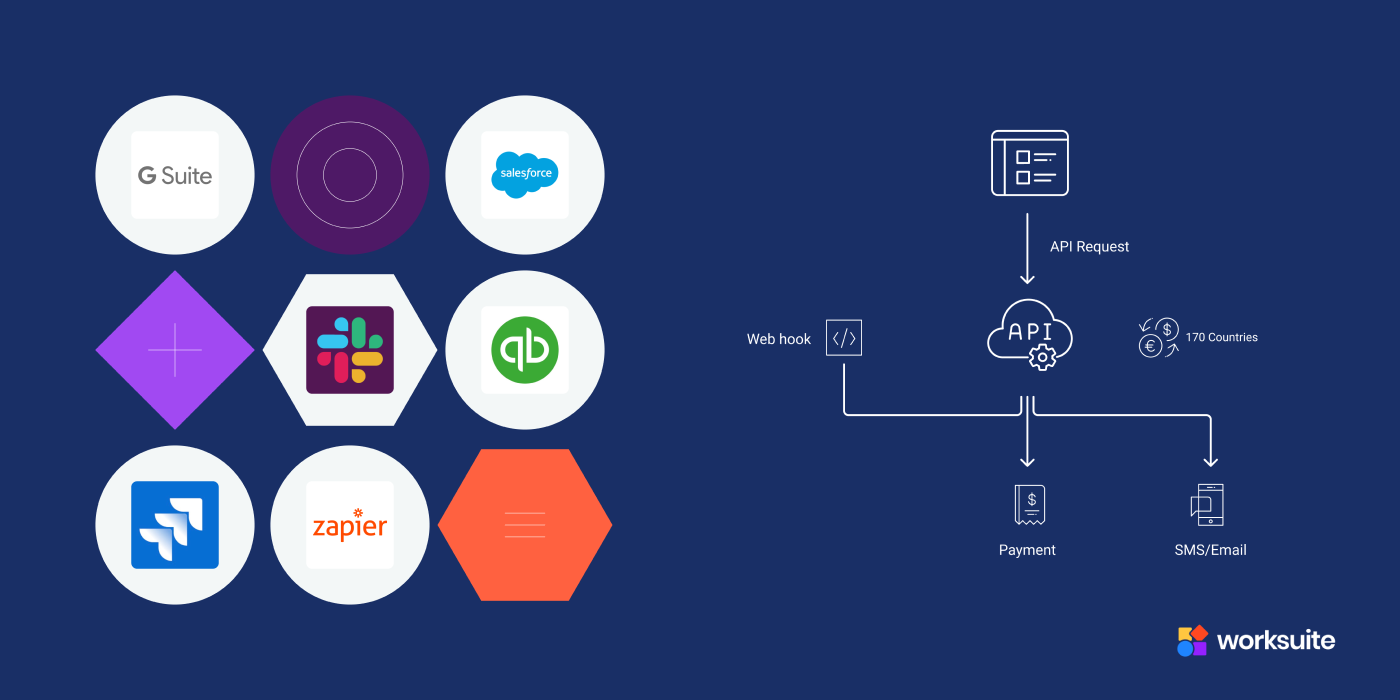
Integrations
In order to get the most out of Worksuite, we’ve made it easy to integrate with your existing finance systems. In addition to the old-fashioned way of integrating your finance data, we are now offering you more control over how your data is synced automatically. Whether you’re looking to create an automated trail of financial records or just want to import important data like invoice details and payment amounts, we have you covered.
Configure payment activity to trigger specific actions. Set custom alerts, auto-update accounting records, and much more.
Connect and import valuable processing data like invoice details, payment amounts, status information, and contractor details.
Explore synchronization possibilities between Worksuite and virtually any finance tool. Create an automated trail of valuable data for record keeping and budget tracking.
Worksuite integrates with most major finance tools like QuickBooks, Xero, and more so that you can easily import valuable processing data like invoice details, payment amounts and status information into Worksuite. Plus, we’ll connect our systems together so that when one system updates, the other will follow suit automatically.
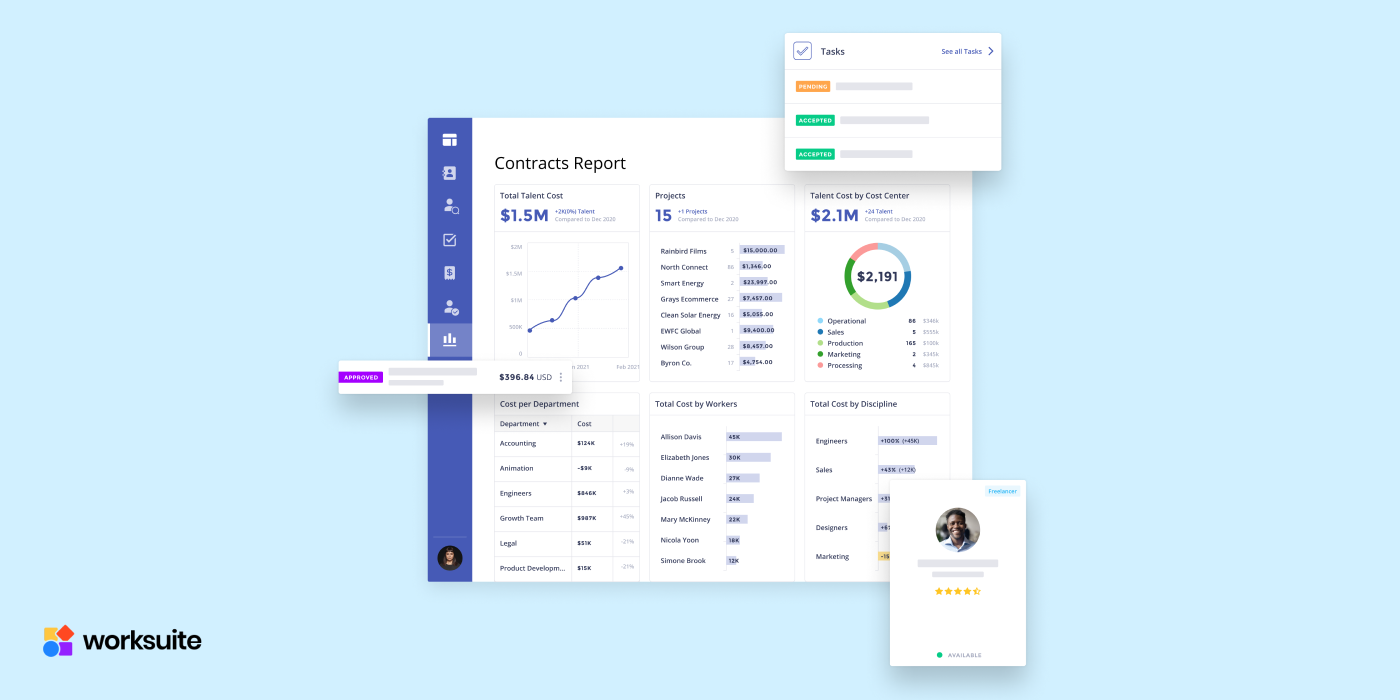
Managing Your Contingent Workforce with Ease
Worksuite offers your organization’s Finance team a centralized hub for managing your contingent workforce.
- Invoice management
- Cost centers, two-level approval
- Timesheet tracking
- Global payment processing
- Currency exchange at competitive FX rates
- Flexible funding options
- Payment compliance
- Freelancer support for bank details and payment delivery
- Global Engage compliance services
- Reporting and analytics
- Third-party integrations for holistic data management
Questions? Reach out to us anytime at support@worksuite.com. We’d be happy to discuss how Worksuite can transform your contingent workforce management.






